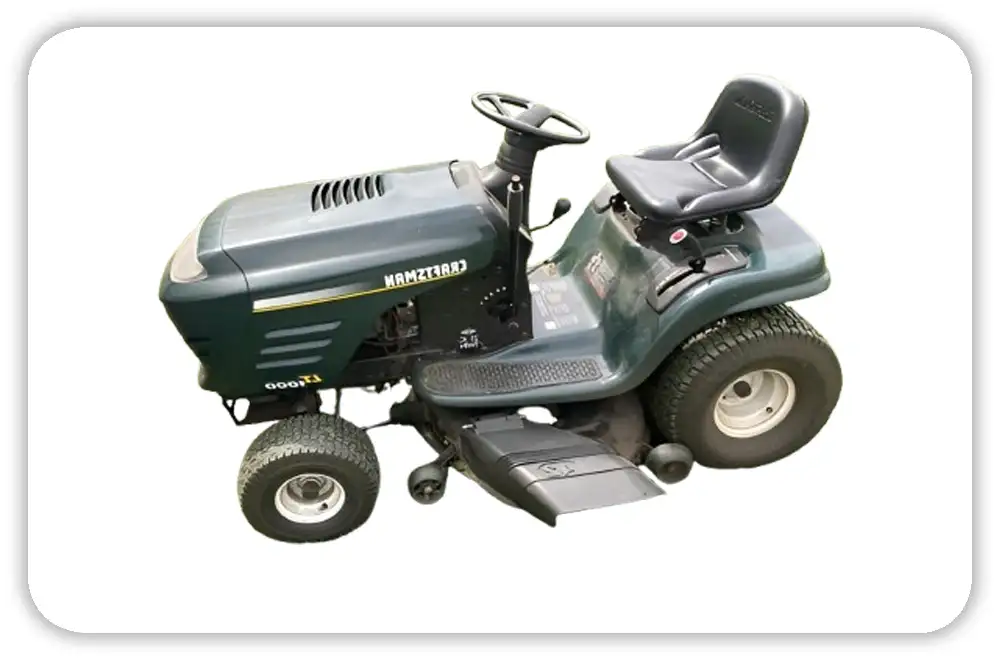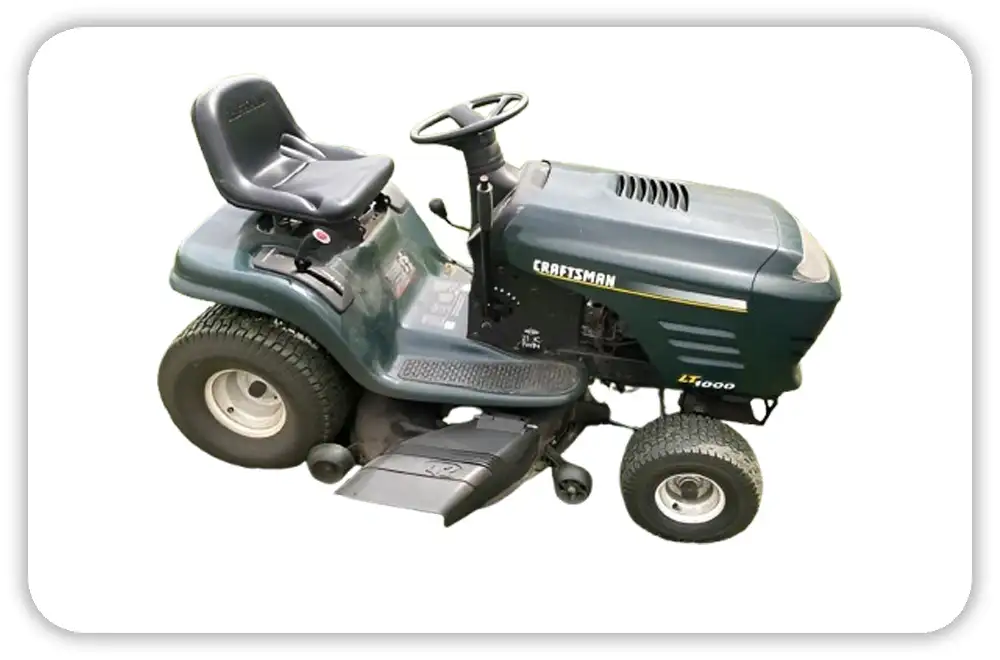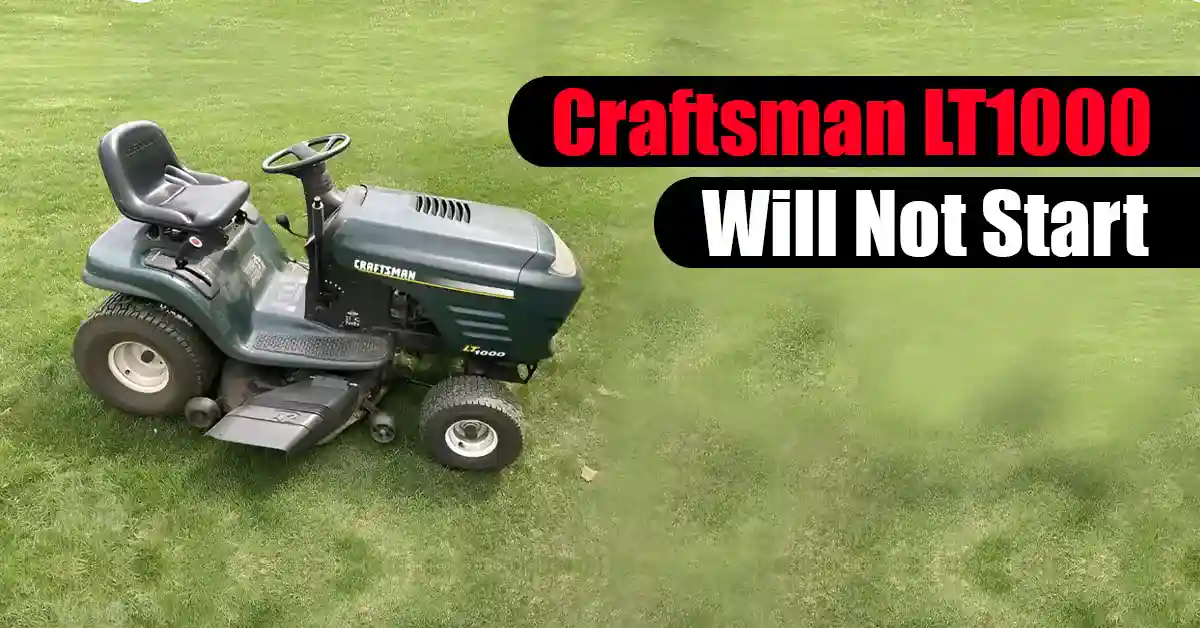Your Craftsman LT1000 won’t start? You’re not alone. Mine quit on me last spring. I turned the key—nothing. Sometimes just a click.
I’ve fixed mowers for years in all kinds of weather, and this one has its own quirks. In this guide, I’ll show you the real fixes that worked for me. No guessing. Just simple steps to get you mowing again.
Table of Contents
Understand the Problem: What Does “Craftsman LT1000 Won’t Start” Really Mean?
When your Craftsman LT1000 won’t start, that can mean a few different things. And each one leads you down a different path.
- No sound at all – You turn the key, and nothing happens. No click. No hum. Just silence.
- Clicking but not cranking – You hear a click, maybe from the solenoid, but the engine doesn’t spin.
- Cranks but won’t start – The engine turns over, but it never fires up.
Each clue tells you something. If you hear nothing, it’s likely a power issue. But if it cranks and won’t start, check the spark or fuel.
Quick Checks to Rule Out Simple Fixes
Before you grab tools or order parts, start with the basics. Some of the most frustrating Craftsman LT1000 “won’t start” problems are actually simple things we overlook.
Is It Plugged In and Powered?
Start with the battery. Are the cables clean and tight? Even a little corrosion can block power. I’ve seen green buildup so thick, the mower might as well have been unplugged.
Next, check the fuse. Many LT1000s have a small inline fuse near the solenoid. If it’s blown, the mower stays silent.
Also, look at the safety switches. The engine won’t crank if the parking brake isn’t set or the PTO is still on.
Try the Jump Start Test
Still nothing? Try jumping the battery—just like with a car. If it starts, the battery is likely weak or dead.
This is common in spring, especially if your mower sat in a cold garage all winter. It happens a lot in the Midwest and Northeast.
If you store your mower over winter, I suggest using a trickle charger. It keeps the battery charged and helps it last longer.
Diagnosing Electrical Failures
If your Craftsman LT1000 still won’t start after checking the battery and safety switches, it’s time to check the wiring and power flow. Don’t stress—it sounds harder than it is. A few simple tests can help you avoid buying parts you don’t need.

Starter Solenoid and Relay Checks
The solenoid works like a bridge between the battery and starter. If it fails, you might hear a click—but nothing else.
Here’s how to test it:
- Find the solenoid near the battery.
- Use a screwdriver to touch the two large posts at the same time.
- Be careful and wear gloves while doing this.
If the engine cranks, your solenoid is bad.
Testing the Starter Motor
If your mower has been sitting, the starter might be stuck.
Here’s what I do:
- Tap the starter with a rubber mallet or the back of a screwdriver.
- Try turning the key as you tap.
If the engine cranks, the starter is likely wearing out. If tapping it works more than once, go ahead and replace it.
Checking the Ignition Switch and Safety Interlocks
The LT1000 has built-in safety switches. If one fails, the mower won’t start.
Seat switch: If it’s unplugged or broken, nothing happens when you turn the key. I once bypassed mine for testing—then reconnected it for safety.
Brake or clutch switch: If the pedal isn’t pushed all the way, or the switch is loose, the engine stays quiet.
These little parts seem minor, but they matter. I’ve seen mowers hauled into repair shops with no power—only to find a loose switch plug was the real issue.
Fuel Delivery Problems
If your Craftsman LT1000 still won’t start—but the engine cranks fine—you’ve likely got a fuel problem. These mowers need clean gas flowing into the engine. If that path is blocked, the engine can’t fire.
Is Fuel Reaching the Carburetor?
Old gas is a common issue. If your mower sat through winter with untreated fuel, that gas may have gone bad. In the U.S., ethanol gas can turn stale in just 30 days. It can leave behind sticky gunk or cause water buildup.
Here’s what to check:
- Fuel filter: Take it off and see if gas flows. If not, it’s clogged.
- Fuel line: Look for cracks or kinks that block gas.
- Vapor lock: On hot days, gas may boil in the line. Try loosening the gas cap to release pressure.
If gas isn’t reaching the carb, your mower won’t start—no matter how good the spark is.
Carburetor Solenoid and Float Bowl Issues
At the bottom of the carb, there’s a small solenoid. It opens to let fuel in when you turn the key. If it doesn’t click, it may be stuck or not getting power.
The float bowl can also get gummed up. That happened to me after mowing on and off all season. The engine would crank but never start.
I pulled the bowl off—and found sticky varnish on the needle valve. Cleaned it with carb spray, put it back on, and the mower started right up.
If you’re comfortable, take the carb apart and clean it. If not, swapping in a new one is cheap and easy—especially if you buy it online.
Spark and Ignition Issues
If fuel is reaching the carb and your Craftsman LT1000 still won’t start, it’s time to check for spark. No spark means no ignition. The engine won’t fire, no matter how hard it cranks.

Using Starter Fluid to Isolate the Issue
This is my favorite quick test. It’s fast, cheap, and tells you a lot.
Here’s what to do:
- Take off the air filter.
- Spray a little starter fluid into the carb opening.
- Try starting the engine.
If it fires for a second and dies, the problem is likely fuel-related.
If it does nothing at all, it could be a spark or compression issue.
Testing for Spark
To check for spark, use a spark tester—or do it the old-school way.
Option 1: Inline tester
- Clip it between the spark plug and the ignition wire.
- Crank the engine. Look for a flash of light.
Option 2: Grounding test
- Take out the spark plug and reconnect the wire.
- Hold the metal tip against the engine block.
- Crank the engine. Look for a blue spark.
No spark? Try this:
- Swap in a new spark plug. It may be fouled or dead.
- Still nothing? Check the ignition coil. If it’s cracked or weak, it won’t fire.
- Make sure the plug wire is tight and not worn out.
A good spark should be strong and blue. A weak yellow spark? That usually means a bad coil or ground issue.
Read More: Craftsman vs John Deere Riding Mower
Engine Compression and Mechanical Checks
If your Craftsman LT1000 still won’t start—and you’ve checked spark, fuel, and the battery—there could be a deeper issue. Let’s look at compression and engine mechanics.
Is the Engine Seized or Hydro-Locked?
This can sound scary—but it’s not always serious.
Try this:
- Turn the flywheel by hand. It sits on top of the engine under the screen.
- If it won’t move, the engine may be seized or hydro-locked.
Hydro-locking happens when fluid—usually fuel or oil—fills the cylinder and blocks the piston.
To test it:
- Remove the spark plug.
- Try turning the flywheel again.
If fluid sprays out, the engine was hydro-locked. Let it air out, clean the plug, and try again. This happens often in humid areas or after tipping the mower.
If the flywheel won’t move and the cylinder is dry, it could be a seized engine. That may mean major damage—and could be too costly to fix if your mower is older.
Valve Lash Issues on OHV Models
Some Craftsman LT1000 mowers have Overhead Valve (OHV) engines. These can develop valve lash problems, which hurt compression and stop the engine from starting.
Watch for these signs:
- Engine spins too fast when cranking, like there’s no resistance.
- Clicking sounds from the top of the engine.
- Engine fires once, then dies every time.
This could mean the Automatic Compression Release (ACR) isn’t working—or the valves need adjusting.
If you’re handy with tools, check the valve clearances using a feeler gauge. Most Briggs & Stratton engines need:
- Intake valve: 0.004–0.006 inches
- Exhaust valve: 0.006–0.009 inches
It sounds tricky, but it’s not bad. I adjusted mine after watching a YouTube video. Took 20 minutes, and the engine fired right up.
In cold states like Minnesota, valves can shift a bit as temps change. I check mine once every season or two.
Maintenance Tips to Avoid No-Start Issues
The best fix is the one you never need. Over the years, I’ve learned that simple upkeep keeps the LT1000 starting strong.
Battery Care in Winter
Batteries hate cold. If you store your mower in winter, bring the battery indoors.
Even better—use a trickle charger. I got mine for $25. It keeps the battery topped up without overcharging. Mine has lasted six seasons so far.
Use Fuel Stabilizer
Gas with ethanol goes bad fast—sometimes in 30 days. It’s even worse in hot places like Texas or Florida.
Add fuel stabilizer if your mower will sit for more than a month. It costs a few bucks and saves your carb.
I started doing this after ruining two carbs in one year. Haven’t had a problem since.
Change Air and Fuel Filters
Dirty filters choke your engine. I swap my air filter every spring and the fuel filter every other year. It takes 5 minutes and a screwdriver.
If you mow in dusty spots—like in the Midwest or Southwest—you may need to change them more often.
Sharpen the Blades and Clean the Deck
This won’t help it start—but it helps it run better. Dull blades strain the engine. A clean deck helps keep it cool.
I sharpen mine with a hand file every few weeks. A few strokes per side is all it takes.
When to Replace vs. Repair
Sometimes, no matter how much you clean, test, or replace, your Craftsman LT1000 just won’t come back to life. So when should you stop fixing and move on?
Signs Your LT1000 May Not Be Worth Fixing
Here’s what I check before spending more time or money on a worn-out mower:
- Cracked engine block or major damage
If the engine is locked tight or has a hole in the side, that’s a big red flag. - Repeat electrical problems
If you’ve changed the solenoid, battery, and starter—and it still acts up—it may not be worth chasing every little fault. - Rusty deck or cracked frame
If the deck is rotting or the frame is weak, the mower won’t last much longer. - Missing or broken parts
If the transmission slips or the steering is shot, repairs can add up fast.
Parts Cost vs. Value
The Craftsman LT1000 is still popular in the U.S., and most parts are easy to find. That’s great news if you’re fixing one.
But keep this in mind:
- A good used LT1000 sells for around $300 to $600.
- If your repairs cost more than half of that, it might not be worth it.
Unless you’re fixing it for fun (and I get that), it might be better to sell it as-is or part it out.
Conclusion
Let’s bring it all together.
If your Craftsman LT1000 won’t start, it’s usually one of four things:
- Electrical – Weak battery, bad solenoid, or a safety switch issue
- Fuel – Old gas, clogged filter, or a stuck float
- Spark – Dead spark plug or faulty coil
- Mechanical – Valve lash off, engine flooded, or maybe seized
Every no-start has a cause. And with a little time and a few tools, you can usually find it.
If I can do it in my garage, so can you. I’ve had mowers quit after long winters, mid-summer heat, or for no clear reason at all. Each time, I learned something new.
Still stuck? Drop a comment below with your symptoms. I’ll do my best to help.
Let’s get that mower running again.
FAQs: Craftsman LT1000 Will Not Start
Why won’t my Craftsman LT1000 start at all—no sound, no click?
If your Craftsman LT1000 will not start and makes no sound, check the battery, safety switches, fuse, and ignition wiring first.
What does it mean if my Craftsman LT1000 clicks but doesn’t crank?
A click with no crank usually points to a bad solenoid, weak battery, or poor connection at the terminals or ground.
My Craftsman LT1000 cranks but won’t start—what should I check?
If it cranks but doesn’t start, check for spark, fuel flow, and carburetor issues. Try starter fluid to narrow it down fast.
How do I test the starter on a Craftsman LT1000 that will not start?
Tap the starter while turning the key. If it cranks after tapping, the starter may be sticking or worn out and needs replacement.
When should I stop repairing and replace my Craftsman LT1000?
If the engine is seized or repairs cost more than half its value, it may be better to replace it instead of spending more.


